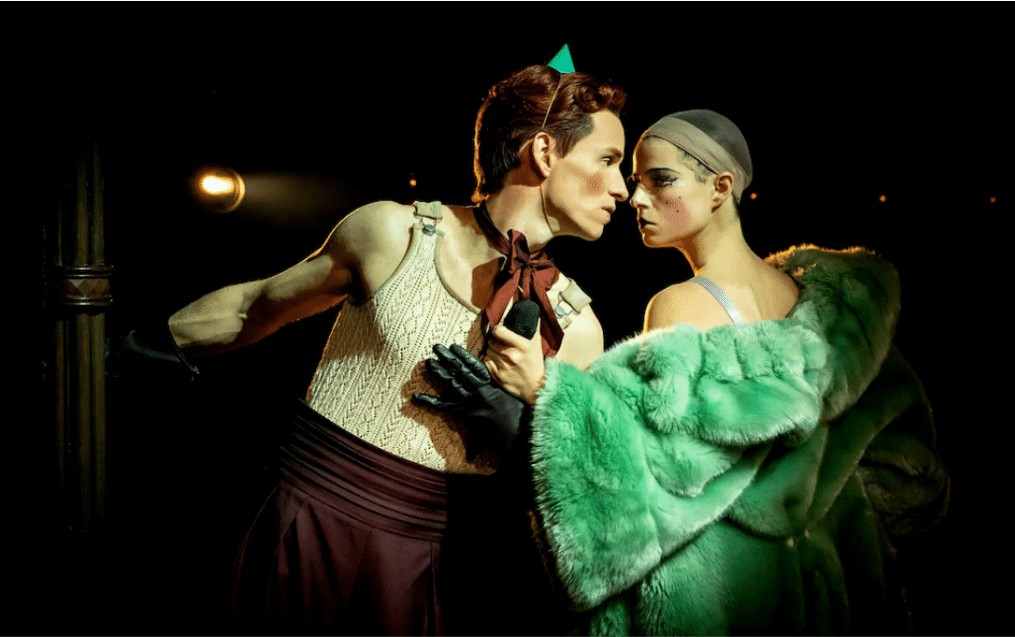But this production, with its roving “pre-show” artistes in foyer areas, and reconfiguration of the proscenium arch into an in-the-round space, reducing the capacity to 550 seats, is in a different league. “You’re not looking into a picture of a room from another time,” Frecknall has said. And it’s exactly that – you’re a visitor, or intruder, then by swift degrees, welcomed in by the emcee, part of the furniture, complicit in the spectacle. Even though you’re primarily watching, it feels participatory – in search of escapism, you surrender to a wilder side, illicit hankerings, felt on the pulse in the seductive tom-tom of the oompah-style music.
As we heard in the speeches at Sunday’s Oliviers, hundreds of people are behind the scenes bringing this labour of love into nightly being. The risks were, and remain, high; the costs involved are reflected in ticket prices some have decried as exorbitant. Theatre outings are generally, on the expensive side, especially compared to a Netflix subscription. But by maximising what “live” theatre offers, something thrillingly in the moment, a venture like Cabaret amply justifies the outlay. Money makes the show go round; you can see, to the tiniest costume-bead, where it has been lavished.
Of course there are singular reasons why the form adopted here matches the “content” so well. It’s hard to see the joins between the bravura realisation of the concept and individual performances – the “totality” of the environment means Sally Bowles sinks into the bowels of the space during the title song while her voice emanates from the depths of her being.
Of course, not every play or musical warrants such invention; and in the wrong hands, gimmickry would prevail. All the same, it feels like a sign-post for other shows to follow.
“Immersive” theatre has long sat on the margins – even though leading pioneers Punchdrunk, opening their new show, The Burnt City, next week, have sought out the mightiest industrial spaces. The popular Secret Cinema has notably striven, with success, to drape film screenings with tie-in performance elements, covertly ceding how much cinema will need to raise its game to lure people out.
There are other, laudable enough examples of West End shows seeking interactive cachet, whether that’s the pre-show antics at The Play That Goes Wrong, the gizmos making the Back to the Future auditorium light up or Moulin Rouge! – Cabaret’s main rival – which has gone the extra mile in seductive decor. But attaining a 360-degree wow-factor in a conventional playhouse, Frecknall and co have gone for broke and broken the mould, pushing artists and audiences unforgettably far out of their comfort zones.

But this production, with its roving “pre-show” artistes in foyer areas, and reconfiguration of the proscenium arch into an in-the-round space, reducing the capacity to 550 seats, is in a different league. “You’re not looking into a picture of a room from another time,” Frecknall has said. And it’s exactly that – you’re a visitor, or intruder, then by swift degrees, welcomed in by the emcee, part of the furniture, complicit in the spectacle. Even though you’re primarily watching, it feels participatory – in search of escapism, you surrender to a wilder side, illicit hankerings, felt on the pulse in the seductive tom-tom of the oompah-style music.
As we heard in the speeches at Sunday’s Oliviers, hundreds of people are behind the scenes bringing this labour of love into nightly being. The risks were, and remain, high; the costs involved are reflected in ticket prices some have decried as exorbitant. Theatre outings are generally, on the expensive side, especially compared to a Netflix subscription. But by maximising what “live” theatre offers, something thrillingly in the moment, a venture like Cabaret amply justifies the outlay. Money makes the show go round; you can see, to the tiniest costume-bead, where it has been lavished.
Of course there are singular reasons why the form adopted here matches the “content” so well. It’s hard to see the joins between the bravura realisation of the concept and individual performances – the “totality” of the environment means Sally Bowles sinks into the bowels of the space during the title song while her voice emanates from the depths of her being.
Of course, not every play or musical warrants such invention; and in the wrong hands, gimmickry would prevail. All the same, it feels like a sign-post for other shows to follow.
“Immersive” theatre has long sat on the margins – even though leading pioneers Punchdrunk, opening their new show, The Burnt City, next week, have sought out the mightiest industrial spaces. The popular Secret Cinema has notably striven, with success, to drape film screenings with tie-in performance elements, covertly ceding how much cinema will need to raise its game to lure people out.
There are other, laudable enough examples of West End shows seeking interactive cachet, whether that’s the pre-show antics at The Play That Goes Wrong, the gizmos making the Back to the Future auditorium light up or Moulin Rouge! – Cabaret’s main rival – which has gone the extra mile in seductive decor. But attaining a 360-degree wow-factor in a conventional playhouse, Frecknall and co have gone for broke and broken the mould, pushing artists and audiences unforgettably far out of their comfort zones.